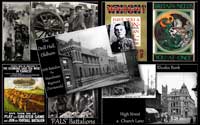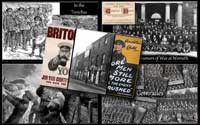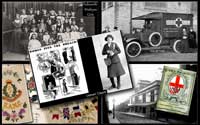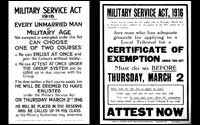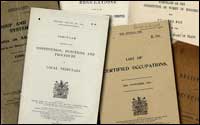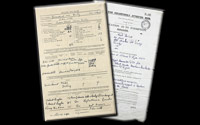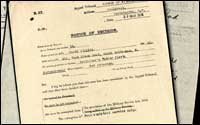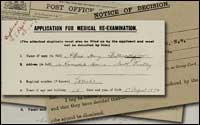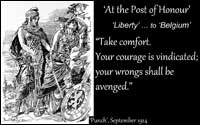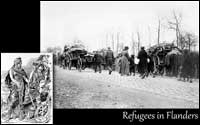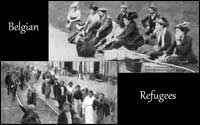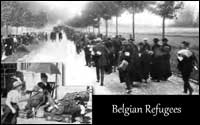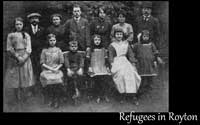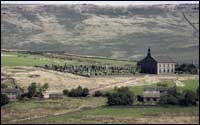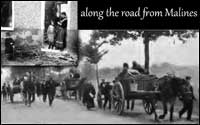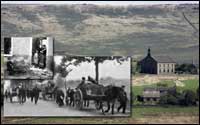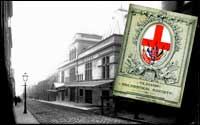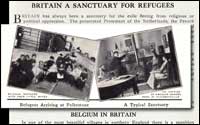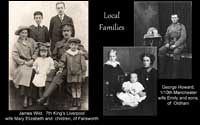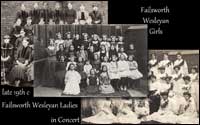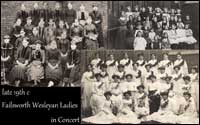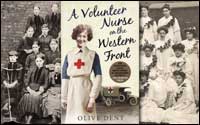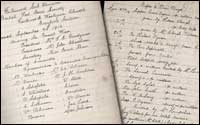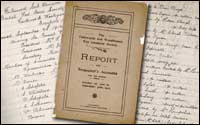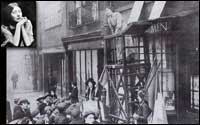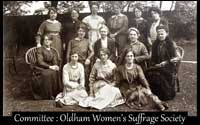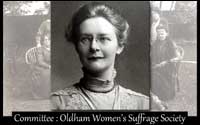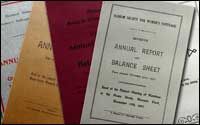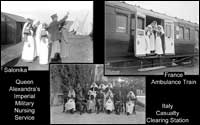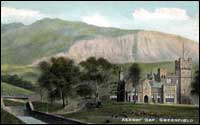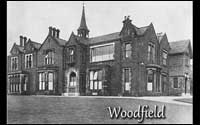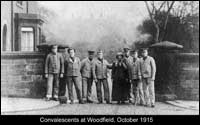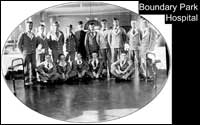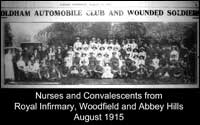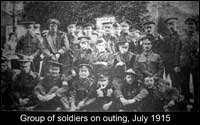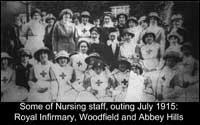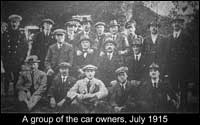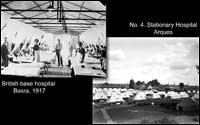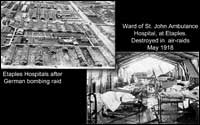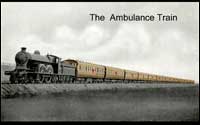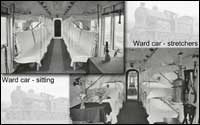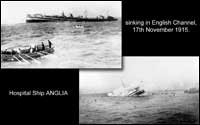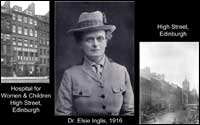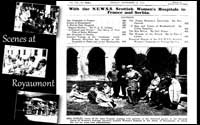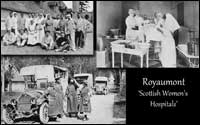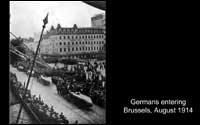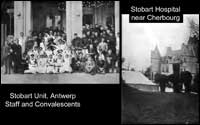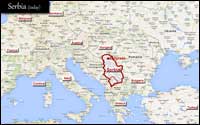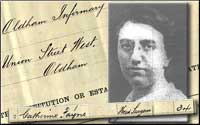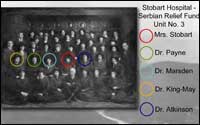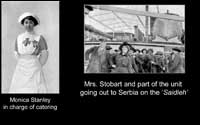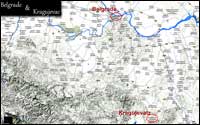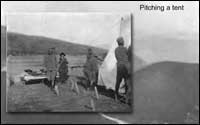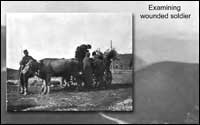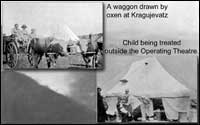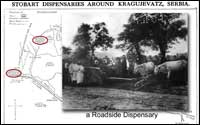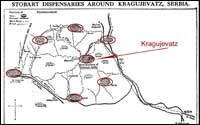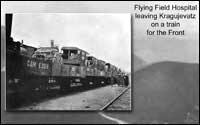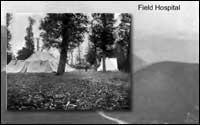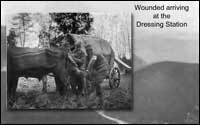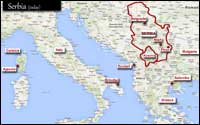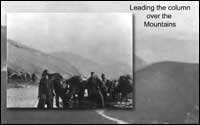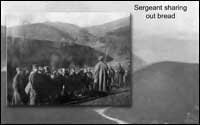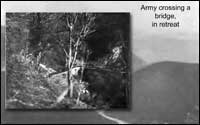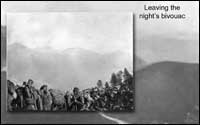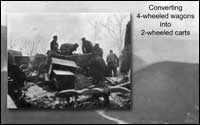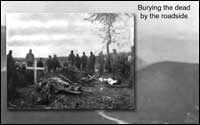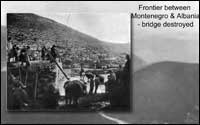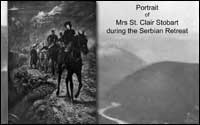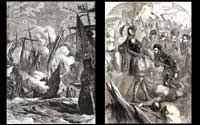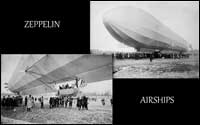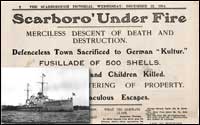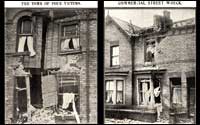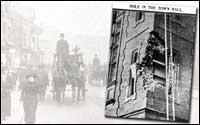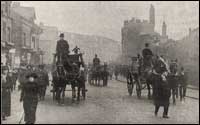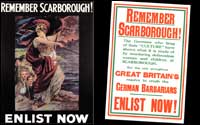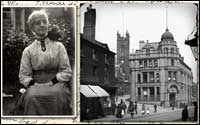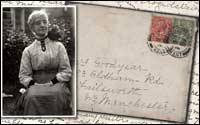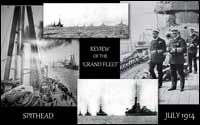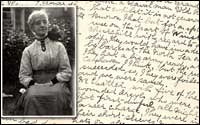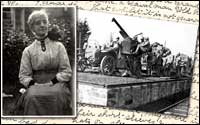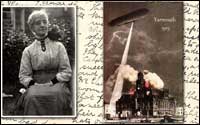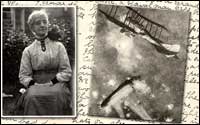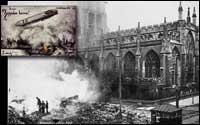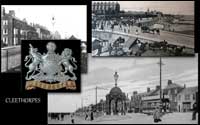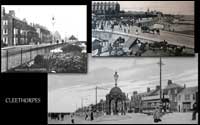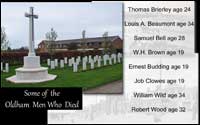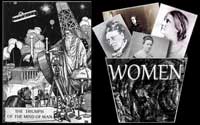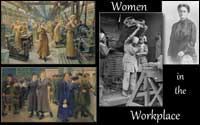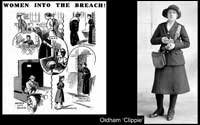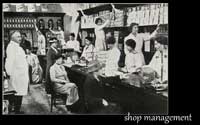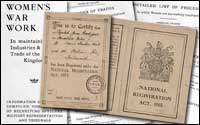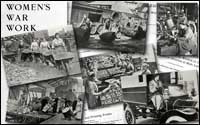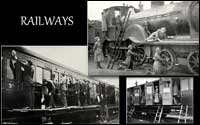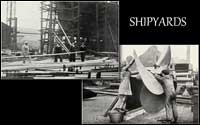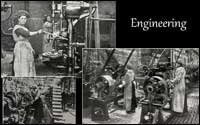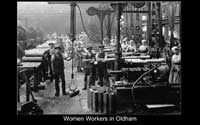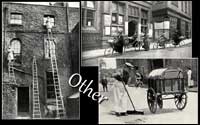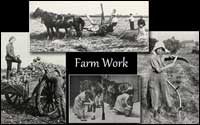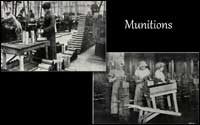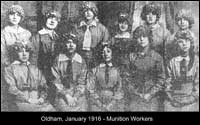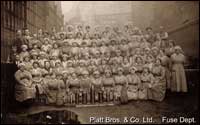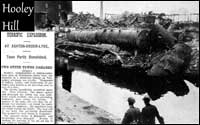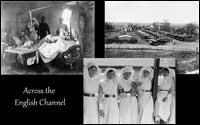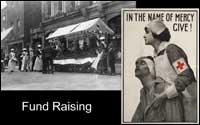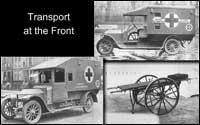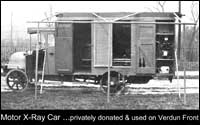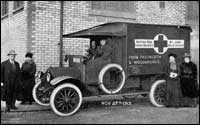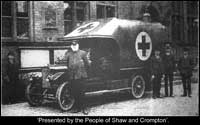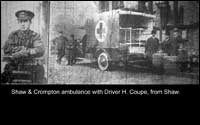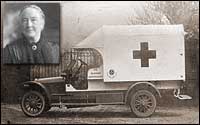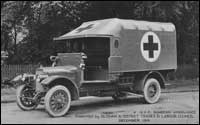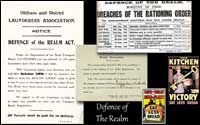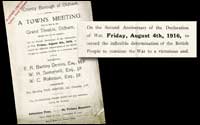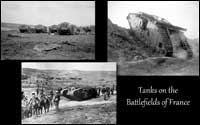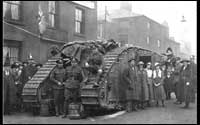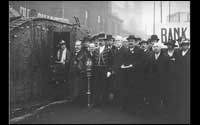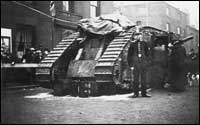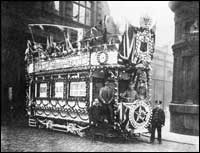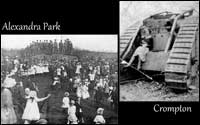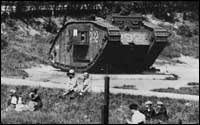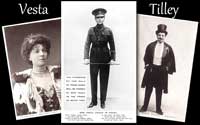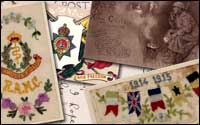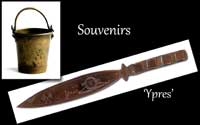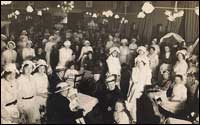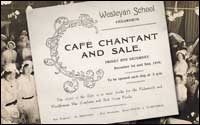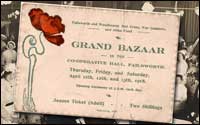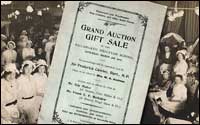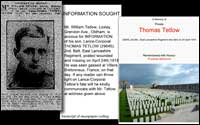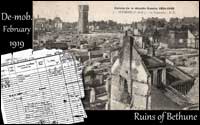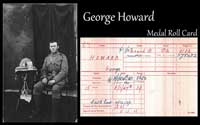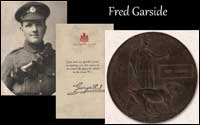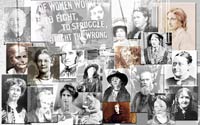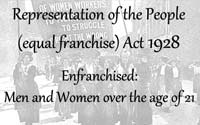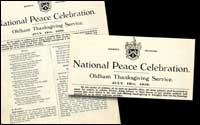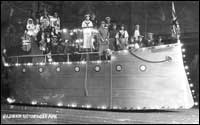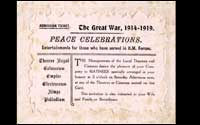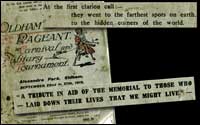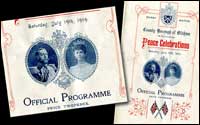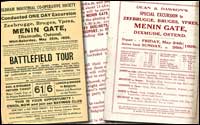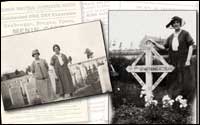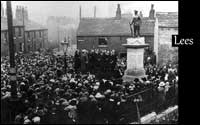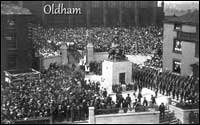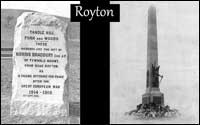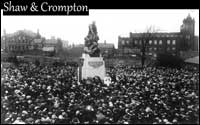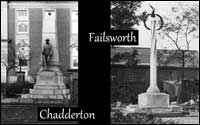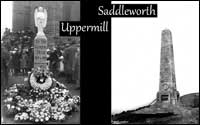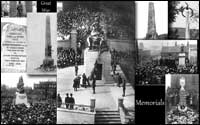
'THE GREAT WAR - HOW IT TOUCHED LIVES IN OLDHAM' PART 2 The Narrative and Slides from the September 2014 Talk at Oldham-HRG |
|||
Click on the the image to see a larger version. |
NARRATIVE
|
||
|
|
Just to refresh our memories ...... After war had been declared, on the 4th August 1914, regular soldiers had been re-deployed to France as the The British Expeditionary force. Reservists had been re-called ... Territorials had been embodied ... and recruiting of civilian volunteers was in full swing by the end of August. |
||
|
|
This talk is complete in itself but was designed to follow the earlier talk (August) that looked mainly at the role of men in the war ..... |
||
|
|
This will be more concerned with a brief look at some of what was happening at home ... and the role of women, both here and abroad .... |
||
|
|
In January 1916 the Military Service Act came into force. |
||
|
|
Local Military Tribunal Boards were set up to consider applications for exemption and interview the applicant. Although there were many booklets and hundreds of pages of guidance issued ... with literally hundreds of possible examples for exemption ... a successful application often depended on the personal bias of the local board members, especially in the case of conscientious objectors. |
||
|
Pages from the
|
There were 7 official 'grounds for Appeal' and put simply, they were.
|
||
|
|
Most successful applicants, on conscientious grounds, were obliged to serve in non-combatant roles ... often at or near the Front. As a further punishment in the 1918 Representation of the People Act they were denied the right to vote in the General Election that year and for the 5 years following the the Treaty of Versailles in 1919. |
||
|
Pages from the |
In Oldham there are reports in the Oldham Chronicle of Tribunals held at Crompton, Chadderton, Lees, Springhead, Limehurst, Royton, Failsworth and Oldham itself. The reports also gave the decision and, sometimes, the verbal exchanges in the room are recorded in full, providing a sense of the feelings and opinions amongst the men. There are a number of reports of conscientous objectors being arrested on the criminal charge of, 'Failing to Comply with the Military Service Act.' One such report was of 3 brothers called Hubert, Stanley and Hayden Greaves, of 1, Leach Street, Royton. They had had failed to attest after having appealed more than once and each time been rejected. When they appeared in court they were each fined 40/- (the minimum fine) and handed over to a military escort. Everyone had an opinion and, in one letter, the Royton Tribunal was accused of being 'too lenient' and, " I am afraid that there is too much sentiment being shown by members of the tribunal ..." It finishes with, "It certainly seems that, next to going into munitions, one's best way to escape service is to live at Royton." |
||
|
|
Britain had many reasons, mainly to do with self-interest, for entering the war against Germany in August 1914 but the publicly stated reason was that Belgium's neutrality had been violated. |
||
|
|
Belgium, which had been safeguarded by treaties for the past 75 years was no match for the power of the German army, as it swept across her borders, looting and destroying everything that stood in its path as the townsfolk and villagers fled before the advance. When the Belgian Government appealed for aid Britain set up a War Refugees Committee and Local War Relief committees were asked to set up sub-committees to organise the relief and find suitable homes in their own areas. Before the end of the war, over 250,000 Belgian refugees would have arrived in Britain, finding shelter and support. |
||
|
|
In Oldham, Mr Nadin, the Secretary of the Oldham Relief Committee, had already received several dozen offers of homes for individual children but the more urgent need was for families to be accommodated together. |
||
|
|
A Belgian Relief Fund was formed and set about raising the money to pay for the furnishing and upkeep of the properties. Offers of help flooded in.... One was from the Oldham Gasworks who agreed to the installation of gas fires and cookers in the Belgian homes and promised that gas would be supplied at a discounted rate. |
||
|
|
The Oldham Chronicle, in mid October, reported that hundreds of well-wishers had gathered to welcome the Byl family, on their arrival in Royton, where they were to be accommodated in 5 large rooms at Royton Hall. The family had escaped from Ghent ... leaving everything behind. |
||
|
|
In the 'Saddleworth Historical Society Bulletin', of Autumn 2010, we can read a considerable amount about what was happening in that locality, most of which was probably being replicated all over the country. Offers of help were immediately received by the Saddleworth Distress Committee and it was also suggested that the untenanted council houses should be made available for refugees. Fund raising for initial expenses, such as furniture and basic necessities, was going to be a priority and was started immediately. |
||
|
|
In the early months there was a great deal of press enthusiasm, with only a few voices of dissent or caution. So great was this enthusiasm that in some places, such as Saddleworth, the only shortage was of Belgian families to take up residence ... Offers were currently exceeding demand! In November, at a meeting of the Distress Committee, it was suggested that, with 10 empty houses offered and ready for occupation but with, as yet, no families to put in them, that 2 of them should be made available for the use of convalescent soldiers. One, Oakdene, would later become the first Military Hospital in Saddleworth. In December, the only refugees to have actually arrived were those of a family called Foreff, in Bleakhey Nook. The Foreff family had been discovered by a local businessman, Mr. Greenwood, whilst visiting Manchester. On hearing their sad story, he immediately offered them a cottage and settled them there at once. |
||
|
|
In autumn 1914 another family was installed in a house and was being supported by the Delph Independent Methodists, This family, like the Foreffs, were originally from Malines which had been over-run by the German forces. Perhaps, as yet, most people believed that these would only be temporary financial burdens, on both the individuals and the councils, and few were considering that this might be a commitment for an unknown and lengthy number of years. In January 1915 the Distress Committee was supporting 45 refugees in Saddleworth. To raise funds they organised illustrated lectures, band and choral concerts, and welcomed cash donations. |
||
|
|
In Oldham, the Orchestral Society staged a fund raising concert at the Empire Theatre, in December 1914. Attended by civic dignitaries, and with evening dress worn in the dress circle, it was a gala occasion. In Saddleworth, as the months dragged on, the first hesitant voices of criticism began to be heard, in early 1915, when the refugees didn't like the locally baked bread and the Belgian diet was full of fish ... cheap enough in Belgium but much more expensive in villages such as Saddleworth. |
||
|
|
How well did the refugees fit in with the English way of life...? As the years went by, did the finances become a burden ... ? In 1916, Belgian men were exempt from conscription under the 1916 Military Act. Even today, many questions remain only partially answered. |
||
|
|
When their sons and brothers, husbands or lovers, marched off to war, the women left behind had a burning need to show their support; to offer help and comfort, in whatever ways they could. Groups of women had organised themselves within weeks of the outbreak of war, to 'do their bit'. |
||
|
|
Formed by the women and girls, on September 26th, 1914, one of these groups was known as, 'The Failsworth Sub Division, Red Cross Society, Failsworth Wesleyan Methodist Church, Comforts Section' ... to give it its full title! |
||
|
|
The group raised funds for materials and knitted and sewed its way through many thousands of pairs of socks, gloves, shirts, slippers, scarves, caps, bandages, blankets and so on, whatever nwas needed. The money raised paid for an ambulance, stretchers, materials, treats and trips for convalescents. |
||
|
|
In her book, 'A Volunteer Nurse on the Western Front', Olive Dent, devotes several pages to the praise of War Comforts, to the women who laboured over them at home and the recognition of just much they were appreciated by the men. |
||
|
|
In February 1916, many of these local groups, including Failsworth Wesleyan, combined together in order to centralise their organisation for greater efficiency and effectiveness. Read more about them HERE |
||
|
|
There were about a dozen groups within the Failsworth and Woodhouses Society but many dozens of subscribers listed as having donated money or goods. Unfortunately, although we find passing references to their existence, the detailed reports that still exist are thin on the ground ... |
||
|
|
Women had been organising themselves, in action groups, for the past 50 years, as they campaigned for women's rights in both society and the workplace. Not forgotten, but put to one side in the face of greater need, many of these organisations, especially the women's suffrage, now channeled their energies into support of war aid. |
||
|
|
Here in Oldham, the Women's Suffrage Society, with Marjory Lees as its president, agreed with the NUWSS policy that, ".... we must show ourselves worthy of citizenship ... whether our claim to it be recognised ... or not." As in the past, Marjory Lees and her mother, Dame Sarah Lees, were swift to offer their personal aid. Marjory paid for free milk, for expectant and nursing mothers, in 454 families. In the first 3 months of the scheme, in 1914, this amounted to 1594 pints of milk each week. |
||
|
|
The members of the Oldham Suffrage Society organised the milk distribution through their 'visitors'. These women also worked with the 'Oldham Committee for the Care of Women and Children', establishing clothing depots, throughout the town, to provide warm clothing for those in need. |
||
|
|
The annual report, in October 1915, for the Oldham Society states that, "While the Empire is losing thousands of its citizens on the battlefield, it is incumbent upon us women to rescue from death, through neglect, poverty, ignorance and disease, the babies of whom the future state will stand in such urgent need." |
||
|
|
One of the few jobs considered acceptable, for a woman, was that of nursing and in 1914 many nurses volunteered to serve with the armed forces in military hospitals. |
||
|
|
It was very quickly obvious that there were just not enough existing military hospitals to cope with the casualties. One solution, was to requisition suitable buildings and convert them into temporary hospitals, such as that at Ashway Gap House, in Greenfield ...
|
||
|
|
and another at Woodfield in Oldham. In Oldham, in September 1914, the Chronicle reported that "... The governors of the infirmary have decided to place forty beds at the disposal of the military and naval authorities..." |
||
|
|
Seen here are convalescents at the gates of Woodfield in 1915. To try and put the situation into context, in 1914,
|
||
|
|
in July 1916, after the Battle of the Somme began, Boundary Park Hospital, which was part of the Workhouse complex of buildings, was also taken for the care of wounded soldiers. There were also numerous small, privately set up hospitals such as that near Altrincham, the Stamford Military Hospital, at Dunham Massey House. |
||
Keen to help with the rehabilitation of wounded servicemen, on several occasions, the Oldham Automobile Club took nurses and convalescents, from Woodfield, Abbey Hills hospital and Oldham Infirmary, for a day's excursion in a convoy of cars. |
|||
In July 1915 the newspaper recorded that approx 100 nurses and patients went out for the day and had a picnic at Park Farm, Over Peover. |
|||
Some of the nursing staff who went with them. |
|||
|
|
And the car owners who took them: |
||
|
|
In theory, near the Front line, there were First Aid Posts which dealt with minor wounds and accidents. |
||
|
|
However, even the hospitals in Etaples, in 1918, could be dangerous places ... they were part of a vast military complex and became a target for German bombers. |
||
|
|
The more seriously wounded soldiers, those who had suffered a 'blighty', would be nursed until considered strong enough to survive the rigours of the journey back to England. The casualties would make the journey to the coast in specially equipped hospital trains or even barges where appropriate. |
||
|
|
Inside the train were separate carriages for different purposes. Here we see a ward car for those able to travel sitting up and another for stretcher patients. A hospital ship would transport them across the channel to a hospital on home ground. |
||
|
|
The channel trip home could be almost as dangerous as the battlefield ... even hospital ships, clearly marked as such, became targets for German u-boats. |
||
|
Read more about her in:
|
In 1914, the few professionally qualified women, including those in medicine, were still finding it almost impossible to gain acceptance in the male dominated institutions. Female Doctors offered their services to the Military and to the British Red Cross ... and were famously refused! Drs. Louisa Garrett Anderson & Flora Murray immediately founded the Women's Hospital Corps and, with the French Red Cross, set up hospitals firstly near Calais and then in Paris. Dr. Elsie Inglis turned to the Scottish Suffrage Society for financial aid and founded the 'Scottish Women's Hospitals' with the support of the NUWSS. (National Union of Women's Suffage Societies) The first of the Scottish Women's Hospitals was established, by Dr. Inglis, in the Abbey of Royaumont, in France and was in operation by January 1915. It would care for 11,000 casualties before it closed in March 1919. In total ... the 'Scottish Women's Hospitals' established 14 units in some of the worst conditions imaginable and raised £449,000 in fundraising for them. |
||
|
Read more about it, online, in:
|
There were other voluntary organisations operating, wherever there was fighting, and included:
|
||
|
Read more about it in:
|
One of the ways in which the NUWSS raised funds was to ask donors and suffrage societies to, 'name a bed' and donate the funds for its maintenance. |
||
|
|
One nurse who felt impelled to volunteer was Mrs. Hallam, the widow of John Hallam, an Oldham Estate Agent. We know, from a newspaper account in October 1915, that she went out to Brussels in early August along with 99 other volunteers. It was only a matter of days later, on the 20th of August, that Brussels was over-run by the Germans. |
||
|
|
Impatient with the War Office's refusal to send women doctors to the battle zones, Mrs. St Clair Stobart, who had already organised a hospital and staff for both the French and Belgian Red Cross, responded to a plea for help from the Serbian authorities. |
||
|
|
Serbia, having seen fierce fighting in the Balkan Wars of 1912 & 1913, was in desperate straits. With thousands of men dead or wounded, the country was also in the throes of a typhus epidemic and desperately in need of medical help. |
||
|
|
Four of the doctors who joined Mrs. Stobart's unit going to Serbia had worked at Oldham Infirmary. Dr. Catherine Payne had come to Oldham in 1910 to take up a post firstly at the Infirmary and then as Medical Officer with the Poor Law Union. |
||
|
|
The volunteer staff for the unit was gathered together ... |
||
|
Read more in: |
On April 1st 1915, 19 members of the 45 strong unit sailed from Liverpool for Salonica, where they would meet up with the others. The four Oldham Doctors were amongst those sailing with Mrs Stobart. |
||
|
|
Two weeks later they landed safely at Salonica and found that the final destination, for our Oldham Doctors and Mrs. Stobart, was to be Kragujevatz, about 60 miles south east of Belgrade. |
||
By April 23rd they had reached Kragujevatz ... had found a suitable site for their tented hospital ... had pitched their tents ... and installed their equipment.
|
|||
They were ready for business and the wounded started to arrive. The hospital staff were virtually all women but there were about 40 Austrian POWs who did the heavy work around the unit. |
|||
By the beginning of May, although their primary objective was the treatment of wounded soldiers, it was realised that a Dispensary for the civilian population, was also needed desperately. Many of the Serbian doctors had either died in the typhus epidemic or were serving with the army. |
|||
Mrs Stobart wrote... |
|||
So successful was it that it was decided to establish a ring of the dispensaries within a 30 mile radius. Money was again raised by the Serbian relief fund and extra staff and equipment were sent out. A total of 6 dispensaries were set up. |
|||
As autumn arrived the threat of enemy action grew greater. Rumours about the enemy armies massing on the frontiers were rife and the Serbian army was also mobilising. The rest of the unit remained in Kragujevatz and a few months later were evacuated safely and returned to England. Meanwhile on the 1st of October Mrs. Stobart's flying field ambulance, packed into 6 motor ambulances and over 30 ox wagons was loaded onto the train. |
|||
Their destination was Pirot ... on the Bulgarian border. By the 4th of October they'd arrived ... and the hospital tents were pitched and operational. |
|||
Within days the Serbian army was overwhelmed by the enemy ...
|
|||
Then the order came to move. Tents were struck and all packed back into the wagons. The retreat had begun ... from Austrians & Germans advancing from the north and Bulgarians from the East.
|
|||
It was to be a long trek that would last 3 months ... through horrific conditions ... the sound of gunfire never far behind them ... and a constant stream of sick and wounded to care for.
|
|||
It's impossible to tell the full story of the retreat in a few short sentences or convey any idea of the conditions endured ...
|
|||
The hospital unit retreated, as part of the military convoy, through mountains and along rocky roads that were choked with refugees fleeing from the advancing enemy armies.
|
|||
Day by day they waited for orders ... whether to pitch camp, whether to move to the next destination .... all the time treating the sick and wounded along the way.
|
|||
Added to the horrors was the constant need to find food for themselves and for the horses and oxen.
|
|||
The dead and dying ... both human and animal, were on all sides.
|
|||
Winter came to add to their miseries ... with snow, frostbite and soaking rain ...
|
|||
Finally, they reached the coast at Scutari and, eventually, but with great difficulty, found a boat to take them to Brindisi, in Italy .. and then it was a train to Paris ... and home in London by New Year, 1916.
|
|||
Read her book: |
Dr. Payne returned to Oldham but sadly, within months was seriously ill. She died on February 4th 1918 and is buried in Chadderton Cemetery. |
||
Over the centuries England had endured invasion ... threat of invasion ... and civil war ... |
|||
Without warning, death came from above with bombs dropped by Zeppelin airships flying high above the earth and searching for targets of strategic importance ... but often only destroying homes and families. |
|||
In Scarborough it came whistling through the air .... massive shells bringing death and destruction ... |
|||
|
|
Mr W.T. Hirst, an employee of Hirst Bros, Wholesale jewellers, was in Scarborough on business and wrote that he was just getting up, in his hotel bedroom, when he heard the first sounds of firing. |
||
|
|
In Hartlepool, Mrs. Jane Whitehead, from Delph, lived at one of the hotels with her family. She wrote that, she'd already sent her daughter off to school and, when she heard the first sounds, assumed that it was gunners at the fort, practising. |
||
|
|
An Oldham man, working in Hartlepool, sent an account of events to the Oldham Chronicle. In it, he mentions ... the gasworks blazing, the railway station damaged, the deaths of a woman and his friend's child. |
||
|
|
He ends his narrative with the words, He was right ... 'Remember Scarborough' became a popular slogan in the recruitment campaign. In all, 137 people were killed and 592 injured in the attack. |
||
In 1915, an elderly Oldham couple, Mr and Mrs. Bradbury, were living in Broadstairs, Kent. Richard Bradbury was a dental surgeon. Before they went to live in Kent they had lived firstly on Lees Road, then on Church Terrace, in the centre of Oldham, from which address Hannah ran her dressmaking business. |
|||
|
(Read one of her letters, in full, HERE) |
In 1915, she wrote to her friend in Failsworth about the happenings in Broadstairs since the beginning of the war... She wrote, "August 1914, a telegram came for the military band that was here ... to join their regiment at once ..." |
||
The Royal Review of the Grand Fleet had taken place only days before war was declared and, further on in the letter, she writes about it ... "Battleships and destoyers were on either side of us ... 50 big battleships sailed gloriously past ..... like so many guardian angels ... Then another lot of 19 ... with a Dreadnought in front ... looking for all the world as if they were playing 'follow my leader'. " |
|||
She wrote of seeing the first hospital ship arrive with the wounded soldiers and Belgian refugees... |
|||
And another time she mentions Zeppelins appearing overhead, " ... guns were firing, rockets shooting up and flash lights going." ... A later letter from her refers to the wounded, and she writes, "Isn't it wonderful how the boys keep up the spirits ... and yet what pitiful sights we see ... " |
|||
She writes of more attacks by the Zeppelins ... one bomb missing a hospital but hitting a girl's school before being chased away by fighter planes, and just a couple of weeks later, she tells of a bomb being dropped, killing a group of children on their way to Sunday School. |
|||
Another day, she writes of watching an aerial battle ... |
|||
Even before 1914, the Germans had realised the potential of the airship in war. They were capable of a speed of 85 miles per hour and could carry 2 tons of bombs. Initially unprepared, the east coast was particularly vulnerable to attacks from the airships coming across the North Sea and considerable damage, with civilian casualties, was suffered. |
|||
Oldham itself never actually suffered a bombing raid, although Zeppelins passed overhead and bombs were dropped not so many miles away, as in Bolton. However, a group of Oldham soldiers was killed in an airship attack on another town. They were in the Regular Army's 3rd Battalion (Reserve) of the Manchester Regiment. In March 1916, a number of the regiment were sent to Cleethorpes, on the East Coast, to strengthen the Humber Defences in that locality. On arrival, and unaware that danger was already approaching through the air, the men unpacked their kit and settled down for the night in their billet in a church hall. |
|||
The approaching Zeppelins were intending to bomb London and East Anglia but one, finding it had engine trouble, decided to make the best of a bad job and bomb Grimsby. Catastrophically, it mistook the seaside town of Cleethorpes for the port of Grimsby. |
|||
According to reports, of the 84 men in the building, 32 died immediately or as a result of their injuries (at a later date), and 48 were injured. Just 4 men, playing a game of cards in the cellar, were unharmed. Two years later, this Special Memorial to the men was unveiled in the Cleethorpes cemetery. On the CWGC website HERE, can be found 28 names of those in the 3rd Battalion of the Manchester Regt. who died on that date. Of these, 9 are identified as being from the immediate Oldham area.
|
|||
As we know, the oubreak of war saw a turning point in the battle for women's rights. In the years before 1914 many professions and occupations were virtually closed to women. However, in the workplace. women workers had begun to make their voices heard, as they came together in unions and campaigned for better pay and working conditions. |
|||
From 1914, as the demand for men, materials and armaments grew ever more urgent, and more and more men enlisted or were conscripted, the only people left to fill the gaps were WOMEN ... It was the opportunity to prove that they could do any job that a man could do ... |
|||
They stepped forward in their hundreds of thousands, to do just that! Many men maintained that women weren't physically or mentally capable of the work or esponsibilities ... But women proved the critics wrong. |
|||
They weren't just given the jobs behind counters or in offices ... |
|||
Read it in full HERE |
The 1915 National Registration Act had identified numbers of men and women who had skills that could be 'used' more effectively for the war effort. |
||
|
|
In the booklet, there were 28 pages indexing trades in which women could be employed along with the specific processes involved. There were 70 photographs of women actually employed in those jobs and, just so there could be no excuse, it included the addresses of the local labour exchanges where women could, 'do their duty and volunteer'. |
||
There was work on the Railways ... |
|||
in the shipyards ... |
|||
Women were employed to labour in engineering workshops ... |
|||
In this photograph we see Oldham women working in an engineering works. |
|||
And there were also 'non-industrial' occupations, such as, |
|||
And, of course, farm work ... |
|||
And last, but definitely not least, work in the giant munitions industry meeting the incessant demand for bullets, bombs and shells .. |
|||
|
|
In this newspaper photo, from January 1916, we are shown a group of local munition workers. |
||
|
Read 'Women of the War'
|
The official photos usually show us smiling faces ... women glad to 'do their bit' ... but the reality was frequently different. |
||
|
|
In Ashton, on July 13th 1917, there was an explosion in the munitions works manufacturing TNT for bombs, at Hooley Hill. |
||
|
|
As we look back we can see that the fighting was happening overseas ... industry was geared up to supply the needs of a nation at war and people left at home turned to any activity which would support and comfort the servicemen. |
||
However, only time and labour were truly 'free' so virtually everything that was done carried a cost. Consequently, much of the work at home, was the often thankless task of fund-raising.
|
|||
One of these was for the provision of motor ambulances and wheeled stretchers for use in front-line areas. |
|||
And this is a mobile X-ray unit ... privately donated and in use at Verdun. |
|||
By August 1915, Failsworth & Woodhouses War Comforts Society, had organised a collection amounting to £860 ... enough to buy not only an ambulance but also 10 'Field, Hand Ambulances'. This must have been a daunting sum of money, for any group to raise, but raise it they did. |
|||
The money for this ambulance was raised by donations in Shaw and Crompton ... and the wish was expressed that it would be driven by local man, Driver H. Coupe, and be used in the area of Dunkirk. |
|
||
Dame Sarah Lees presented the Oldham Branch of the St. John Ambulance Society with a fully equipped ambulance, which she named, 'The Oldham Suffragist. It's seen here before setting off for France in December 1915. |
|||
This one, presented in January 1916, was bought with funds raised by Oldham & District Trades and Labour Council. A serious concern of the TLC was that of an ever growing realisation that manufacturers and large investors were making fortunes from the war and, after it was over, the working man would bear the financial burden of higher taxation to pay off what would become a massive National Debt. One of the more immediate concerns was that food prices had increased whilst the purchasing power of the pound was dropping. Another serious and pressing issue was the increase in rent charges. Consequently the Rent Restriction Act was brought in, in 1916. When it was largel;y ignored, a later ammendment to it froze rents at their 1914 level, if they had been below 10/- (10 shillings).
|
|||
DORA was the acronym by which the Defence of the Realm Act was known. It was introduced on the 8th August, 1914, and new restrictions ... were added as and when the need was recognised. The Act was designed to give the government far ranging powers enabling it to subordinate all activities to the needs of War. Government was given the right to requistion buildings or land and the output of factories needed for war work.
|
|||
By August 1916, and 2 years of conflict, a war weary population had to be kept on-side. There could be no wavering ... |
|||
By September 1916 the tank, up to recently a closely guarded secret, had put in a welcome appearance on the battlefields of the Somme. |
|||
In February 1918, Oldham found itself with a tank, called 'Egbert', on Yorkshire Street, near the Town Hall. 'Egbert' had been in the Battle of Cambrai, in November 1917 and it became part of a national investment campaign ... raising money to pay for the war by urging people to buy War Bonds and War Savings Certificates. |
|||
There was a grand opening of the Oldham 'Tank Bank' on the 9th February, by the mayor, who ceremoniously invested £100,000 for the council. The target investment for the town was £1,000,000. |
|||
That target had been reached within a week, after 6 days of virtually non-stop activities ... bands playing, medal presentations, a procession led by an illuminated tram and 4,000 children, brought from their classrooms to view it and then asled to write their essays.
|
|||
A final tour of Oldham, Crompton, Shaw, Royton and Lees, by the illuminated tram on the 15th brought the investment figure up to its target £1,000,000. Altogether, Oldham and the townships, invested over one and a half million pounds in that week. |
|||
'Egbert' moved on to other towns but, at the end of the war, both Crompton and Oldham were given tanks of their own, and Oldham's found a home in Alexandra Park. |
|||
In November 1914, Vesta Tilley, the famous music hall male impersonator, visited Oldham and gave a performance at the Palace Theatre. |
|||
Although the servicemen were never far from the thoughts of family and friends they'd left behind, the men, in their turn, thought constantly of home. Letters and cards were precious to everyone ... |
|||
In France, particularly, there was a thriving 'cottage industry' in souvenirs which were often made from exploded shell casings and the like, for instance, letter openers, ash trays and other similar souvenirs were all offered for sale, bought by the soldiers and sent home. Even 'souvenir' bullets, removed from a wound in hospital,. would be sent home with pride ... all would be treasured by family and passed down the generations. |
|||
At home, there was no let-up in fund raising ... the list is endless ... |
|||
concerts ... dances, whist drives and garden parties ... |
|||
bazaars ... sales of garden flowers, decorated cards and hand made craft items ... |
|||
and Gift auctions ... with donated items ranging from expensive jewellery to half a dozen cups and saucers ... and no amount was considered too trivial to add to the 'pot' |
|||
But, for someone, every day there was heartache ... a death confirmed or the anguish of a loved one 'missing in action'. One such was this notice in the newspaper, pleading for news of a missing son. The family hopes would be crushed .... on the Commonwealth War Graves commission website can be found this record of his death in that month and on that date. |
|||
After over 4 long years of war, the armistice was signed with Germany on the 11th November 1918. The hardest part, now, was for the families waiting for their men to come home, and for the servicemen, wanting nothing more than to get home and get on with their lives. For the majority, this would drag on well into 1919. |
|||
For most, there would be medals to recognise their service in the different theatres of war and for the years in which they served. Sometimes, there would be the medals recognising courage and valour ... |
|||
But, for hundreds of thousands of families, there was no celebration ... just a memorial plaque and certificate, to mark their sacrifice, and place alongside the medals. |
|||
Life would never be the same, again, for anyone. In 1918, Parliament, compelled to extend the franchise to all men over the age of 21, now found it virtually impossible to refuse to include women.
|
|||
10 years later and, although there was still considerable resistance, the vote was finally extended to all women on the same conditions as men. (Read about Women's Suffrage HERE) |
|||
Back to 1919, and there were celebrations to mark the end of war ...
|
|||
|
In July 1919 Oldham had a decorated 'Victory Car', as part of the 'Peace Celebrations ... But not all the men coming back felt like heroes ... |
|||
In the 1920s, visits to the war began cemeteries and memorials began to be organised ... offering a chance for relatives to visit graves and see memorials such as the Menin Gate ... |
|||
|
But time moved on and, in the years that followed, virtually every town and village, raised money for public war memorials. Thousands of churches, schools, institutions, factories and offices installed their own memorial boards, books, and scrolls ... |
||
In 1914, when being urged to enlist, the men were promised that their sacrifices would never be forgotten ... but now, 100 years later, can there be anyone left whose memory reaches back to those years? Our responsibility, in this centenary year, is to remind ourselves of the horrors that touched our own and virtually every family in the land ... and remember those men and women who served, suffered and sacrificed ... and to try and keep faith with that early promise.
|
|||
|
Grateful Acknowledgements
|
||
Contributed by Sheila Goodyear |
|||
World War 1Project MENU PAGE
Members' pages MENU
